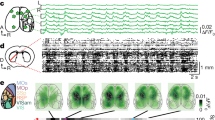Summary
The sources of afferent input to the striatum (caudate nucleus and putamen) suggest that this structure may be engaged in neuronal processes related to the initiation of movement. We found that 26% of 508 neurons in both parts of the striatum were activated during the presentation of visual signals which prepared the animals for the execution or withholding of individual arm reaching movements. In a second task, 20% of 382 striatal neurons were activated up to 3 s before self-initiated, non automatic and purposive arm movements which were performed in the complete absence of phasic external stimuli. The data demonstrate an involvement of the striatum in externally and internally generated processes which are related to presetting mechanisms during the initiation of behavioral acts.
Similar content being viewed by others
References
Alexander GI (1987) Selective neuronal discharge in monkey putamen reflects intended direction of planned limb movements. Exp Brain Res 67: 623–634
Andén NE, Carlsson A, Dahlström A, Fuxe K, Hillarp NA, Larsson K (1964) Demonstration and mapping out of nigrostriatal dopamine neurons. Life Sci 3: 523–530
Buchwald NA, Price DD, Vernon L, Hull CD (1973) Caudate intracellular response to thalamic and cortical inputs. Exp Neurol 38: 311–323
Buser P, Pouderoux G, Mereaux J (1974) Single unit recording in the caudate nucleus during sessions with elaborate movements in the awake monkey. Brain Res 71: 337–344
Divac I, Rosvold HE, Szwarcbart MK (1967) Behavioral effects of selective ablation of the caudate nucleus. J Comp Physiol 63: 184–190
Eccles JC (1982) The initiation of voluntary movements by the supplementary motor area. Arch Psychiat Nervenkr 231: 423–441
Fuster JM (1973) Unit activity of prefrontal cortex during delayed-response performance: neuronal correlates of transient memory. J Neurophysiol 36: 61–78
Godschalk M, Lemon RN, Nijs HGT, Kuypers HGJM (1981) Behaviour of neurones in monkey peri-arcuate and precentral cortex before and during visually guided arm and hand movements. Exp Brain Res 44: 113–116
Goldman PS, Nauta WJH (1977) An intricately patterned prefronto-caudate projection in the rhesus monkey. J Comp Neurol 171: 369–386
Hikosaka O, Wurtz RH (1983) Visual and oculomotor functions of monkey substantia nigra pars reticulata. III. Memory-contingent visual and saccade responses. J Neurophysiol 49: 1268–1284
Jacobsen CF, Nissen HW (1937) Studies of cerebral function in primates. IV.The effects of frontal lobe lesions on the delayed alternation habit in monkeys. J Comp Physiol 23: 101–112
Kemp JM, Powell TP (1970) The cortico-striate projection in the monkey. Brain 93: 525–546
Kimura M, Rajkowski J, Evarts E (1984) Tonically discharging putamen neurons exhibit set-dependent responses. Proc Natl Acad Sci USA 81: 4998–5001
Kornhuber HH, Deecke L (1965) Hirnpotentialänderungen bei Willkürbewegungen und passiven Bewegungen des Menschen: Bereitschaftspotential und reafferente Potentiale. Pflügers Arch Ges Physiol 284: 1–17
Kubota K, Niki H (1971) Prefrontal cortical unit activity and delayed alternation performance in monkeys. J Neurophysiol 34: 337–347
Libet B, Gleason CA, Wright EW, Pearl DK (1983) Time of conscious intention to act in relation to onset of cerebral activities (readiness-potential): the unconscious initiation of a freely voluntary act. Brain 106: 623–642
Neafsey EJ, Hull CD, Buchwald NA (1978) Preparation for movement in the cat. II. Unit activity in the basal ganglia and thalamus. Electroencephalogr Clin Neurophysiol 44: 714–723
Niki H, Watanabe M (1976) Cingulate unit activity and delayed response. Brain Res 110: 381–386
Nishino H, Ono T, Sasaki K, Fukuda M, Muramoto KI (1984) Caudate unit activity during operant feeding behavior in monkeys and modulation by cooling prefrontal cortex. Behav Brain Res 11: 21–33
Okano K, Tanji J (1987) Neuronal activities in the primate motor fields of the agranular frontal cortex preceding visually triggered and self-paced movement. Exp Brain Res 66: 155–166
Poirier LJ (1960) Experimental and histological study of midbrain dyskinesias. J Neurophysiol 23: 534–551
Rolls ET, Thorpe SJ, Maddison SP (1983) Responses of striatal neurons in the behaving monkey. 1. Head of the caudate nucleus. Behav Brain Res 7: 179–210
Romo R, Schultz W (1986) Discharge activity of dopamine cells in monkey midbrain: comparison of changes related to triggered and spontaneous movements. Soc Neurosci Abstr 12: 207
Romo R, Schultz W (1987) Neuronal activity preceding self-initiated or externally timed arm movements in area 6 of monkey cortex. Exp Brain Res 67: 656–662
Rosvold HE, Delgado JMR (1956) The effect on delayedalternation test performance of stimulating or destroying electrically structures within the frontal lobes of the monkey brain. J Comp Physiol 49: 365–372
Schultz W (1986a) Activity of pars reticulata neurons of monkey substantia nigra in relation to motor, sensory and complex events. J Neurophysiol 55: 660–677
Schultz W (1986b) Responses of midbrain dopamine neurons to behavioral trigger stimuli in the monkey. J Neurophysiol 56: 1439–1462
Schultz W, Studer A, Jonsson G, Sundström E, Mefford I (1985) Deficits in behavioral initiation and execution processes in monkeys with 1-methyl-4-phenyl-1,2,3,6-tetrahydropyridine-induced parkinsonism. Neurosci Lett 59: 225–232
Tanji J, Taniguchi K, Saga T (1980) Supplementary motor area: neuronal responses to motor instructions. J Neurophysiol 43: 60–68
Walter WG, Cooper R, Aldridge VJ, McCallum WC, Winter AL (1964) Contingent negative variation: an electric sign of sensori-motor association and expectancy in the human brain. Nature 203: 380–384
Author information
Authors and Affiliations
Rights and permissions
About this article
Cite this article
Schultz, W., Romo, R. Neuronal activity in the monkey striatum during the initiation of movements. Exp Brain Res 71, 431–436 (1988). https://doi.org/10.1007/BF00247503
Received:
Accepted:
Issue Date:
DOI: https://doi.org/10.1007/BF00247503




